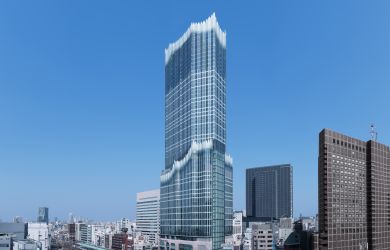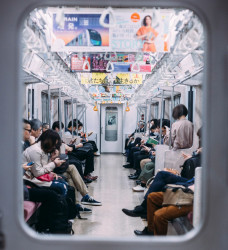
February 17, 2011
The Manga Wars
What’s really at stake in Japan’s revised pornography laws?
By Metropolis
Originally published on metropolis.co.jp on February 2011

Illustration by Cynthia Butler
It is a well worn cliché for Western tourists to return home from Japan and tell stories about—shock, horror—nerdy, bespectacled salarymen reading pornographic manga on crowded trains, oblivious to the group of chatty schoolgirls seated nearby.
In reality, almost all books read on trains here, comics or otherwise, are wrapped in those nondescript brown bookshop covers, so it’s nigh impossible to pick the “dirty old man” from someone reading up on how to grow parsley.
But the fact remains that a student only has to nip into any one of the thousands of Lawsons or 7-Elevens which populate Tokyo to be exposed to a legion of half-naked, wide-eyed, big breasted cartoon characters occupying the front covers of the shop’s adult manga collection.
But that is all about to change. Or is it?
The controversial manga censorship ordinance pushed through by the Tokyo Metropolitan Government late last year has been much talked about but widely misunderstood. Specifically, the act aims to regulate manga that “unreasonably praise or exaggerate” extreme sex.
When ten major publishing houses announced they would protest the law by boycotting the upcoming Tokyo International Anime Fair and holding a rival festival (see Agenda), the stage was set for a fight of comic book proportions.
On one side is the Tokyo Metropolitan Government, led by the people’s hero, the lovable and famously open-minded (cough, cough) governor himself, Shintaro Ishihara.
Facing off against him are the motley defenders of free speech—long-haired, absinthe-drinking manga-ka, Japanese beatniks for the computer age battling for their smutty art while their publishers count rolls of yen in smoky backrooms.
Despite Ishihara’s George W. Bush-like grace, the man seems, at least at first glance, to be on the right side of the moral divide. Who, after all, could object to the idea of preventing minors from seeing graphic images that glorify rape, child abuse, incest and underage sex?
The new regulations are being depicted by the publishers as a wider attack on freedom of speech, but, in fact, they place no restrictions on the sale of manga to adults, nor do they restrict what manga-ka are allowed to create. When the new rules go into effect this summer, the outcome will simply be that a greater number of manga get slapped with an R-18 rating. This designation means that the publication must be placed in a separate adults-only section.
The publishers cry that this will significantly damage their business—giving the books an R-18 rating, they say, not only keeps them out of the hands of minors, it reduces the numbers of adults who will buy them. In convenience stores, where space is at a premium, the adult-only section is very small or nonexistent, thus reducing the chance that an R-18 manga will even reach the shelves.
But a deeper look suggests that this is about something more than just publisher profits.
Censorship of pornography in Japan, be it animated, photographed or filmed, has always been superficial, focusing on blocking out or blurring the sex organs. At the same time, the actions depicted onscreen, and the wider themes of the story, are entirely free of any restrictions. In other words, even after the new law goes into effect, a hardcore film about rape can be legally circulated as long as there is a small fuzzy spot over the center of the actors’ genitalia.
This is diametrically opposed to the Western style of censorship, which allows full nudity but which takes a tougher line on rape and sexual violence. Japan’s new law, insofar as it strives to regulate more than just the surface images to look at the overall theme of the story, suggests that the country is moving in a Western direction.
This appears to be a more healthy approach, especially when dealing with impressionable minors, but it also dips into the murky waters of subjective interpretation. The publishing industry is rightly concerned that the new regulations are too vague and potentially broad in their application. They are worried the restrictions will be used to wedge open the door to wider controls on the representation of any illegal activity, including manga with educational value. For example, a story set in the Edo era could be banned if it includes a scene of horny samurai bonking in the Yoshiwara.
Sex today, violence tomorrow—soon, there is very little which can be shown in a comic book.
The TMG has assured publishers and fans that only manga encouraging “indecent” sexual behavior among minors will be censored. It claims that tasteful depictions of “normal” sexual relations between a husband and wife, for example, will not be censored, nor will “positive” stories in which (say) a young person who is sexually abused winds up overcoming this hardship.
But is the TMG really qualified to make difficult judgment calls like this? Is it really possible to determine what “normal” sexual relations are? Different people have different values about human sexuality and what kind of content is appropriate for teenagers to look at.
And don’t forget—after hours and hours of discussion and pointless aisatsu between overworked bureaucrats and militant PTA mothers, one man gets to make the final decision about whether your kids can or can’t read a comic book.
And that man is Governor Ishihara, the courageous defender of that downtrodden and disenfranchised sector of Japanese society—the rich, middle-aged, middle class male Japanese businessman without Korean or Chinese ancestry who invariably likes golf.
Let’s keep the kids safe, but not let this city turn into Ishihara’s personal 1984!







